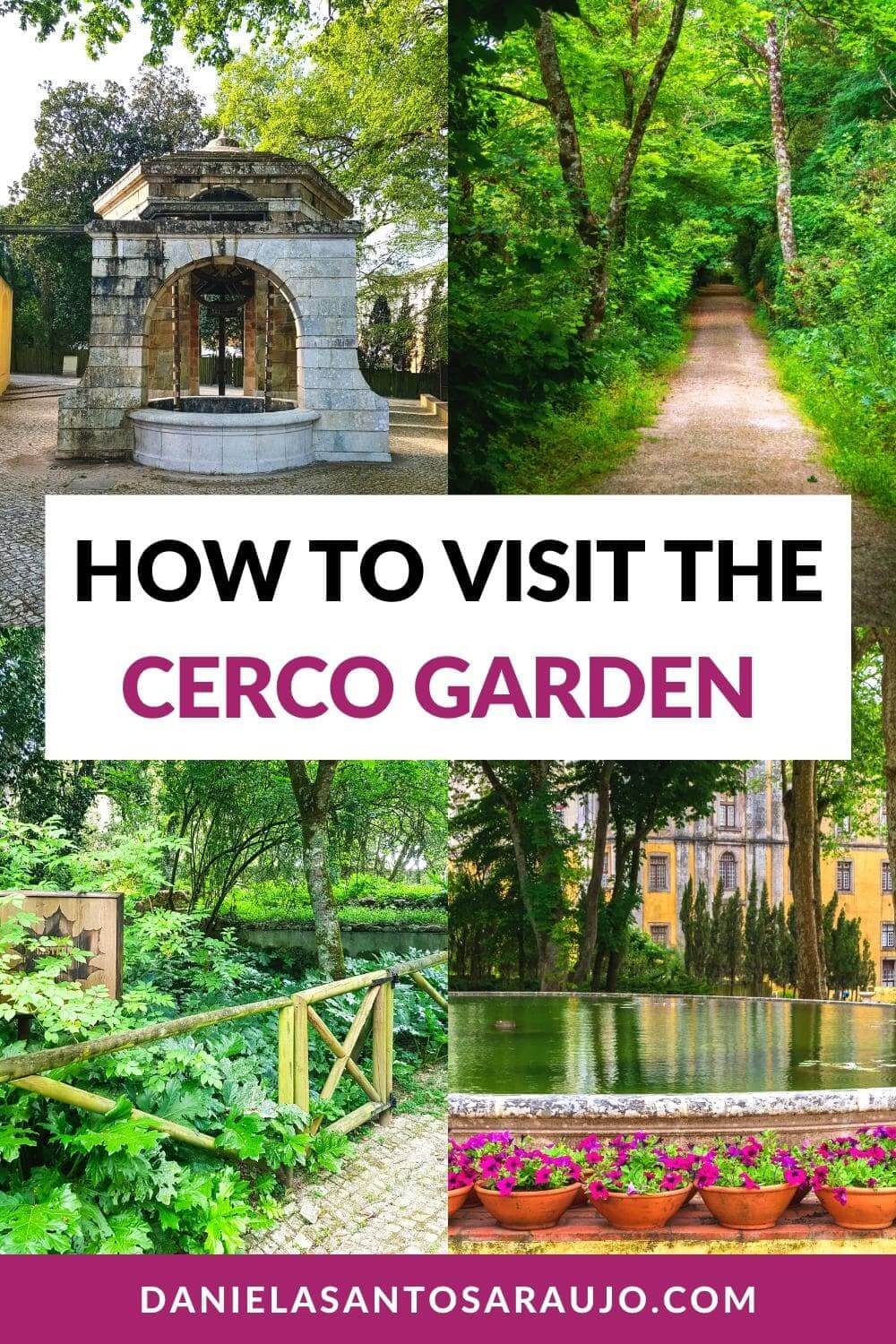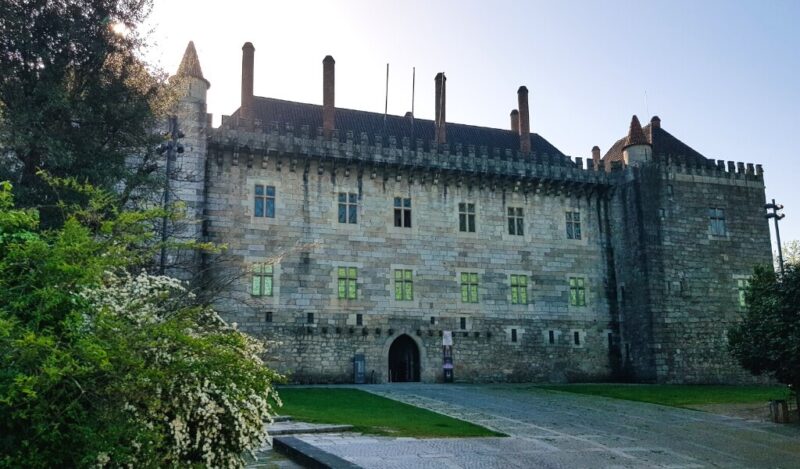The Cerco Garden is a baroque garden located next to the Royal Building of Mafra (an architectural complex comprising a palace, a convent, and a basilica). It has about 9 hectares and started out as a conventual fence, housing a formal garden, a botanical garden, a forest, and several leisure areas.
With the extinction of the Religious Orders in 1834, the Cerco Garden became exclusive to the court and the French gardener Jean Baptiste Désiré Bonard was hired to redesign the place, introducing new tree species (many of them exotic).
After having served as a Conventual Garden and a Court Garden for nearly two centuries, the Cerco Garden opened to the public in 1910. As for the inscription on the World Heritage List, that took place on July 7th, 2019, making the Royal Building of Mafra one of the most recent UNESCO sites!
So, do you want to know How To Visit The Cerco Garden In 2024? Keep reading!
This post may contain affiliate links, meaning I earn a small commission if you make a purchase, at no additional cost to you. Please read my disclosure & privacy policy for more information.
No time to read now? Pin it for later!


Brief History of the Cerco Garden
The Cerco Garden was built by King D. João V, in 1718. The responsible for the project (António Soares de Faria and António Rebelo da Fonseca – the latter, since 1728) drew inspiration from the gardens of the Palace of Versailles, creating sumptuous parterres of flowers and shrubs.
The surrounding forest was also designed with geometric and symmetrical patterns, being traversed by wide paths. At first, these were used by the monks as a place of retreat and meditation and, later, for recreational walks of the Portuguese court.

As I mentioned in the introduction, the Cerco Garden ceased to be a conventual fence in 1834, when the Convent of Mafra also interrupted its functions. In 1840, King Fernando II decided to rehabilitate the Cerco Garden and the Royal Hunting Park (currently the National Hunting Park of Mafra), nominating Jean Baptiste Bonard for this purpose.
With the Implantation of the Republic in 1910, the Cerco Garden became a property of the Portuguese State and opened its doors as a public garden. And when the Town Hall of Mafra took over the management of the enclosure in 1994, it quickly began extensive restoration work.
World Heritage
Did you know that the Cerco Garden was part of Portugal’s twelfth set of inscriptions on the UNESCO World Heritage List? This 43rd session of the World Heritage Committee took place in Baku (Azerbaijan), between June 30th and July 10th, 2019.
Only one other Portuguese site was announced in the session: the Sanctuary of Bom Jesus do Monte in Braga.
Nowadays, Portugal is the ninth country in Europe and the eighteenth country in the world with the most UNESCO sites, tied with Czechia and Poland. It has seventeen heritage assets (both cultural and natural) inscribed on the world list of the United Nations Educational, Scientific, and Cultural Organization.
In the meantime, I’ve already had the opportunity to visit fourteen of them:
- Alto Douro Wine Region (2001)
- Convent of Christ in Tomar (1983)
- Cultural Landscape of Sintra (1995) – Chalet of the Countess of Edla, Convent of the Capuchos, Moorish Castle, National Palace of Pena, National Palace of Sintra, Palace of Monserrate, Quinta da Regaleira, Villa Sassetti
- Garrison Border Town of Elvas and its Fortifications (2012)
- Historic Center of Évora (1986)
- Historic Center of Guimarães and Couros Zone (2001, 2023)
- Historic Center of Porto, Luiz I Bridge, and Monastery of Serra do Pilar (1996)
- Monastery of Alcobaça (1989)
- Monastery of Batalha (1983)
- Monastery of the Hieronymites and Tower of Belém in Lisbon (1983)
- Prehistoric Rock Art Sites in the Côa Valley (1998, 2010)
- Royal Building of Mafra – Palace, Basilica, Convent, Cerco Garden, and Hunting Park (Tapada) (2019)
- Sanctuary of Bom Jesus do Monte in Braga (2019)
- University of Coimbra – Alta and Sofia (2012)
How to Get to the Cerco Garden
Most tourists who visit the Cerco Garden take the opportunity to do so on a day trip from Lisbon. Thus, they can spend the whole day in Mafra and discover the main points of interest in the town (namely the five that make up the Royal Building in Mafra and that are UNESCO World Heritage Sites):
- National Palace of Mafra
- Convent of Mafra
- Basilica of Mafra
- Cerco Garden
- National Hunting Park of Mafra


When I visited Mafra, that’s exactly what I did. So, when you arrive in the town, park your car in one of the various parking lots available on the sides of the palace (I recommend this one, which is free) and start exploring the Cerco Garden.
As the garden opens early, it’s the ideal place to start your itinerary in Mafra. Another tip is to bring a picnic and have lunch at the Picnic Park or on one of the many benches in the Cerco Garden. This way, you can visit the National Palace of Mafra in the morning and the National Hunting Park of Mafra in the afternoon (or vice versa)!
Opening Hours & Ticket Prices
The Cerco Garden is open every day from 9 am to 7 pm (April 1st to October 14th) and from 9 am to 5 pm (October 15th to March 31st). But the best part is that admission is free!
If you prefer to travel by public transportation, you can do it by train or bus from Lisbon. Trains leave Lisbon – Santa Apolónia towards Mira Sintra-Meleças and, once at this station, you have to change to a train bound for Caldas da Rainha. Buses run from Lisbon – Campo Grande to Ericeira.
What to See at the Cerco Garden
Omnias Lake
The Omnias Lake is, probably, the first place you’ll pass by in the Cerco Garden, as it’s right at the entrance, after the statue of the goddess Fortuna. By the way, there are three other sculptures of goddesses from Roman mythology (Pomona, Flora, and Ceres), which are scattered through the forest.

Well, the Omnias Lake is an elliptical limestone tank, although it looks more like a giant water mirror. Here, arrives the water coming from the various springs of the National Hunting Park of Mafra, which flows from a very curious spout, shaped like a lion’s head!
Bird Cage
Did you know that there are more than 60 species of birds in the Cerco Garden? While some are permanent residents, others are migratory birds and stay here only in the milder months of the year.
This Bird Cage is actually a set of cages with birds that live here in captivity. You can find it on the right side of Omnias Lake (if you’re facing the entrance).
The most common birds in the Cerco Garden are the parakeet, the red-crested cardinal, the cockatiel, the zebra finch, and the diamond dove. And if you’re lucky, you can find peacocks too!

Parterres
The parterres of the Cerco Garden form the “heart” of the formal garden and are the highlight of this UNESCO World Heritage Site. Surrounded by low boxwood hedges, the various flower beds change color depending on the time of year, providing a unique visual spectacle on each visit!


In all, there are thirty-two parterres inspired by the famous gardens of the Palace of Versailles and grouped into four distinct sections. Two of these sections are placed side by side, at floor level, while the other two are located immediately behind, on a higher plane.
Noria
With more than 7 meters high, the centenary noria of the Cerco Garden is living proof of the genius of the architects and engineers who designed the five structures of the Royal Building of Mafra (National Palace of Mafra, Convent, Basilica, Cerco Garden, and National Hunting Park of Mafra).


Until reaching this stone well, the water from the 32 springs of the National Hunting Park of Mafra runs through an extension of 5 km, which incorporates wells, aqueducts, fountains, lakes, and cisterns. This hydraulic system is so ingenious that it works only with the gravitational force of the water itself!
Friars’ Vegetable Garden
The Friars’ Vegetable Garden of the Cerco Garden is also called the Garden of Aromatics, because of the type of plants that were (and still are) planted here. When the conventual fence was built, the friars of the Convento of Mafra defined this cultivation space right next to the building.
At that time, it was common for members of the clergy to create their own remedies and ointments – and many of these medicinal drugs were made from herbs and plants. In addition, the friars of the Convent of Mafra also planted vegetables, which they incorporated into their food and even accompanied the Royal Family’s meals.


Currently, the Friars’ Vegetable Garden of the Cerco Garden has nearly four dozen species of plants, which were (and continue to be) used for aromatic, medicinal, and flavoring purposes. After going through the various flowerbeds to photograph these herbs, I found:
- Chamomile
- Chives
- Coriander
- French lavender
- Japanese honeysuckle
- Lavender
- Lemon balm
- Lemongrass
- Oregano
- Parsley
- Peppermint
- Rosemary
- Sage
- Spearmint
- Thyme
- Valerian
Aqueduct

The Aqueduct that crosses part of the Cerco Garden was one of the key parts of that “ingenious” hydraulic system.
This was where all the water used for consumption in the Convent and Palace of Mafra passed through, as well as the water for watering the parterres and the medicinal herb plantations, and for filling the various lakes and decorative fountains in the formal garden.
Much of this water was stored in the Noira and the Cistern (the latter located on one of the sides of the forest of the Cerco Garden).
Ball Game
The Ball Game (in Portuguese, “Jogo da Bola”) was a very popular pastime among members of the Portuguese nobility and clergy, and its origins date back to the 15th-16th centuries.
In fact, “Ball Game” is the name given to this open-air venue, where a series of traditional Portuguese games took place, such as the so-called “little orange game” or the “hoop game”.
In the Ball Game of the Cerco Garden, the open space is delimited by a wall with several entrances. And on this same wall, stone benches were carved so that guests could watch the games.

Cistern

The last stop in this detailed guide to the Cerco Garden is quite hidden and may go unnoticed if you’re not paying attention.
It’s the Cistern, another vital component of the hydraulic system that supplied water to the Royal Building of Mafra.
To get to the Cistern from the Ball Game, you’ll have to cross the Picnic Park and the Children’s Playground. After passing through these recreational venues, turn left and you will see the sign “Cistern” in the middle of the dense vegetation!
Share this blog post on your social media!
More Posts about Portugal
4 Best Monasteries In Portugal (That You Should Visit This Year)
5 Best Palaces In Sintra (That You Should Visit This Year)
1 Day In Penafiel: The Perfect Penafiel Itinerary
More Posts about Gardens and Parks
How To Visit The National Hunting Park Of Mafra In 2024
National Palace Of Queluz: Best Tips For Visiting In 2024
How To Visit The National Forest Of The Seven Hills In 2024
More Posts about World Heritage
Palace Of The Dukes Of Braganza: Best Tips For Visiting In 2024
World Heritage In Castile And León (2024)
Machado De Castro National Museum: Best Tips For Visiting In 2024
What Photography Gear Do I Use?
- Camera Body: Fujifilm X-T4 Mirrorless
- Camera Lens: Fujinon XF 18-55 mm F2.8-4 R LM OIS
- Tripod: Manfrotto Compact Action
- Small Tripod: Manfrotto PIXI Mini
- Smartphone Adaptor: Manfrotto PIXI Clamp
- Memory Card: SanDisk 128GB Extreme PRO SDXC









